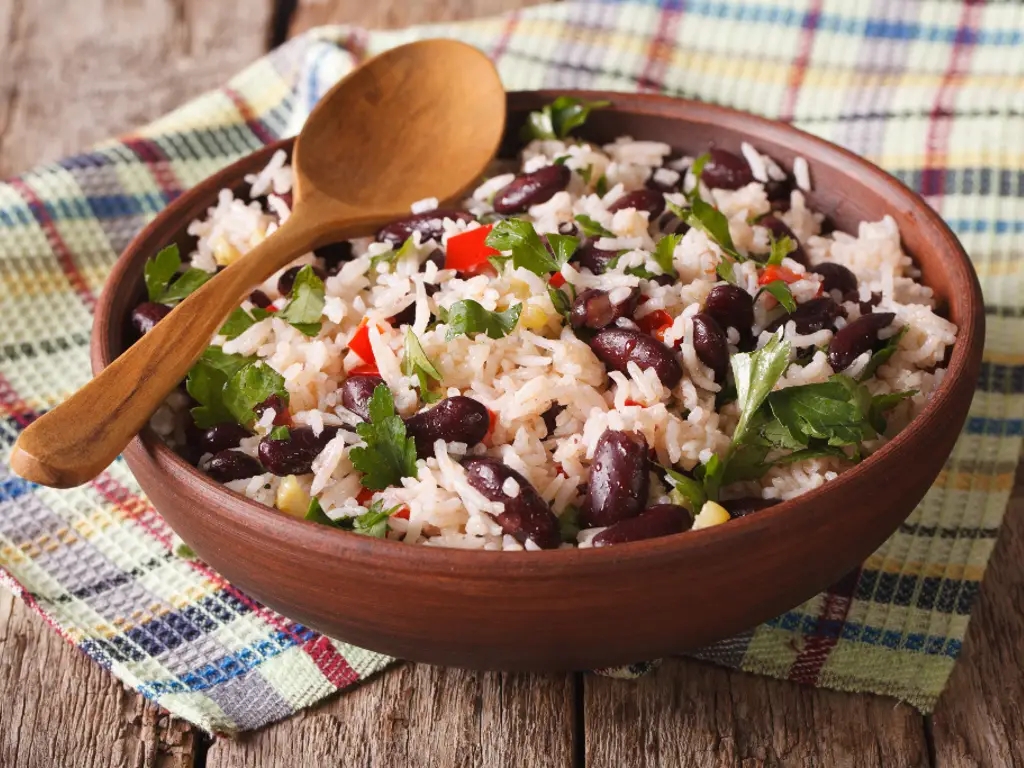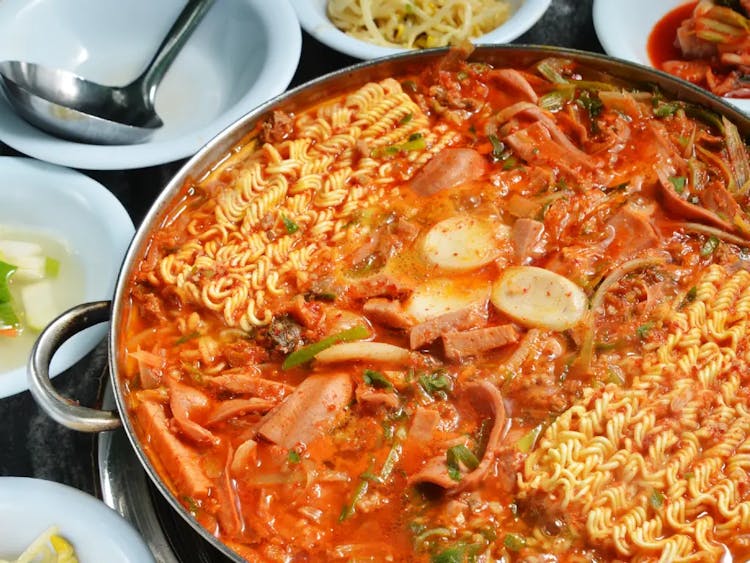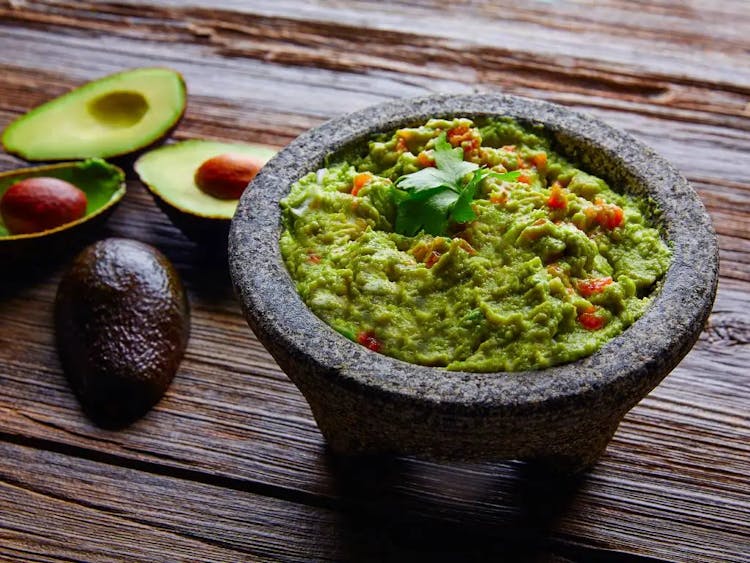
Gallo Pinto: The Rice-and-Bean Combo Integral to a Costa Rican Breakfast
Visit Costa Rica and your chances of trying gallo pinto are extremely high. Translating to “spotted rooster” and traditionally eaten for breakfast, gallo pinto is a speckled combination of white rice, black beans, sweet peppers, onions, and salsa Lizano, which tastes a bit like Worcestershire sauce and was even produced to rival its British counterpart.
The national dish is everywhere—on buffets at tourist-heavy resorts, on the menu of every breakfast-serving restaurant and soda (small, local restaurants found in each town or pueblo), and of course, on the tables of Ticos (citizens of Costa Rica). It’s one thing to test-drive the dish and appreciate the rich and savory flavors complemented with a slight tang (thanks to the salsa Lizano); it's another to understand why the dish is so salient in local culture.

The story of gallo pinto
Where gallo pinto originated is not entirely clear. It is the national dish of both Costa Rica and Nicaragua—and both countries claim it as their own. Its roots are supposedly Afro-Caribbean, with some version of the rice-and-bean mixture brought to the Costa Rican banana plantations by emancipated African slaves from Jamaica and other islands. Once introduced to the region, gallo pinto spread across the two countries, taking on slight regional differences, like which beans you use.
Many cultures around the world lean heavily on rice and beans as cornerstones of daily nutrition. The prevalence, availability, shelf-stability, and cost certainly make them staple foods. There are health-related reasons to eat them. Rice and beans together make a complete protein. They’re full of vitamins, minerals, phytochemicals, and fiber. They’re a healthy and filling option to kick off the day, a day that for many Ticos is filled with activity and manual labor; construction, farming and ranching, day labor, and tourist-centric work like surfing instruction or leading tours are common occupations in Costa Rica—and ones that rely on a hearty morning meal to carry them through until lunch.
There are also financial reasons. While Costa Rica’s economy is growing to provide a better quality of life, the average household income is about $16,000 per year, prices for commodities may soar due to inflation, there are taxes on imported goods, and an influx of expats is driving up prices. Currently, many locals struggle to make ends meet, with a roughly 14% poverty rate in 2022 (similar to that of the US).
Rice and beans are inexpensive options to fill bellies when colones (the local money) fall short between paychecks. Plus, many families have multigenerational households consisting of grandparents, aunts, uncles, cousins, parents, and children living under the same roof or in close proximity. Shared meals for large groups aren’t unusual, so having something affordable to make in bulk keeps food more affordable for everyone.
And there are lifestyle reasons. While most Costa Rican households have a gas cooktop and rice cooker, not every home has an oven or refrigerator. Rice and beans are simple ingredients that can be made with any heat source, even an open flame. They’re easy to make in small amounts or in bulk, and leftovers can be stored and reheated for days.
Finding the good stuff
On my first trip to Costa Rica in November 2018, I remember scooping gallo pinto onto my plate at a hotel buffet. It seemed like the right thing to do: Enjoy a taste of a local favorite alongside fresh fruit, scrambled eggs, and of course, a strong cup of Costa Rican coffee. It was good, but it didn’t leave an impression, at least not the way the country did as a whole.
I loved Costa Rica so much that I returned each month for the next six months, and by the following May, I moved there. The timing was right—I had just experienced a major loss and my job allowed me to work from anywhere. What I needed and craved was change, and Costa Rica’s culture called to me in ways that I hadn’t tapped into in a very long time.
However, I didn’t move to a foreign country for the surface-level experience. I wanted to immerse myself in everything Costa Rica had to offer—the food, language, and pura vida (or “pure life”), the country’s relaxed approach to living each day to the fullest. I developed friendships with Ticos and found myself invited into their homes and to their tables. Breakfasts were always combinations of gallo pinto, eggs, fried plantains or cuadrados (a type of green banana that lacks the sweetness of a banana or plantain), and slices of sausage or avocado. The “extras” changed depending on what the hosts had on hand or could source from their own trees, pigs, or chickens. Gallo pinto, though, was the anchor on every plate.
The dish also anchored me. What had seemed like something to try on my first visit to Costa Rica turned into something I looked forward to—a way to embrace the culture of my new friends, feel included in their lives, and partake in their sustenance. Sitting in an open-air kitchen in the middle of the jungle, the piping-hot gallo pinto served by my friend’s mom was decidedly different from the first scoop I had eaten at the hotel. It felt real, special, and important.
My months in Costa Rica turned into years, and my grasp of the language and culture deepened. I ended up marrying a Costa Rican, living with his family for a time, and it wasn’t long before my kitchen included two Costa Rican staples: a pot of black beans always simmering on the stove and a rice cooker always full of freshly cooked rice. In the mornings, I began to turn the leftover rice and beans into a skillet full of gallo pinto to serve to my family, including my Costa Rican-born children. The importance of the dish became fully ingrained in my newly acquired culture and way of living.

Where to eat gallo pinto
Try it at a local soda
If you're traveling through Costa Rica, ask your hotel or Airbnb host for the best local soda that serves breakfast. They’re practically guaranteed to offer gallo pinto as part of their breakfast menu, and since most owners and cooks are Costa Rican, the recipe is going to be as close to homemade as possible.
Ask for a lesson
If you want to be invited into someone's home for gallo pinto, take some time to get to know the locals, like a tour guide or the server at the restaurant you frequent. Mention that you'd like to learn how to make gallo pinto, and ask if they'd be willing to teach you. Of course, you do need to actually be willing to learn, and you should offer to supply the ingredients. Chances are that you'll be invited to learn and enjoy together. Ticos are incredibly warm and inviting and enjoy sharing their culture with others.
Making gallo pinto
When you have leftover rice and beans, there’s no easier way to cook a hot and filling breakfast than to put them on “remix” and whip up a dish that’s rice and beans—but better. The process is simple and incredibly flexible.
Gallo pinto almost always uses the same ingredients: sweet pepper, onion, salt, salsa Lizano, white rice, and black beans. You can add ingredients like minced garlic (to taste) and fresh cilantro (as garnish). You can also change up the type of beans you use; the Nicaraguan version of gallo pinto almost always includes red beans instead of black.
While there are certainly recipes for gallo pinto, I’ve never seen anyone use a measuring cup when making a batch at home. Adjustments are usually made based on what leftovers are available and how many people need to be served. The ratio of rice to beans is typically 2:1 or 3:2—always more rice than beans—but if you need to feed more people, you can increase the rice and decrease the beans.
The recipe all-in-all is very forgiving; if you have more rice or fewer beans, or if you don’t have a sweet pepper on hand, you can just use what you have and call it good.
Ingredients:
- ¼ cup onion, diced
- ¼ cup sweet peppers, diced
- 1 tbsp oil
- Salt, to taste
- Salsa Lizano, to taste (start with about a tbsp and adjust based on preference)
- 1 cup cooked black beans (leftover, if available, but canned also works)
- 2 cups cooked white rice (leftover works best because it’s drier, but fresh is fine)
- Minced garlic, if desired
- Chopped cilantro as garnish, if desired
- Jalapenos or hot sauce for serving, if desired
- Saute the onions and sweet peppers in the oil over medium-high heat in a large skillet. Add minced garlic, if desired. Cook until soft, stirring frequently, about five minutes. Add a small amount of salt for seasoning.
- Ladle the black beans into the skillet, and stir well until the beans heat through.
- Add the salsa Lizano to the skillet, and stir to combine. For a tangier gallo pinto, add more salsa.
- Scoop pre-cooked rice into the pan with the beans and veggies. Stir well so the rice and beans are evenly dispersed.
- Once warmed through, the gallo pinto is ready to serve. Top with cilantro and serve with jalapeños or hot sauce, if desired.
Read more about delicious dishes around the world:
- Brazilian açaí
- Tahitian chow mein sandwiches
- Georgian Adjaruli Khachapuri
- Marseilles Brik à L'Oeuf
- Korean budae jjigae
- Kansas City burnt ends
- German döner kebab
- Basque marmitako
- Puerto Rican mofongo
- Indian bhang lassi
- Hong Kong char sui
- Roman maritozzo
- Rotterdam kapsalon
- Tampa Cuban sandwich
- Ethiopian coffee
- Colombian arepas
- UK chicken tikka masala
Published October 4, 2023
Last updated January 9, 2024
Treat your travel to cheap flights
Most deals are 40-90% off normal prices with great itineraries from the best airlines. If it's not an amazing deal, we won't send it. Sign up for free to start getting flight alerts.




